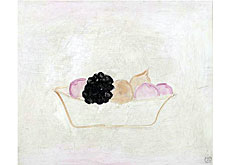Swiss drive interest in Chinese art

Contemporary Chinese art is experiencing a boom in Switzerland, with one of the first ever auctions of these works outside China recently held in Zurich.
It follows on from a controversial but widely acclaimed exhibition held in Switzerland in 2005 of Chinese art collected by former Swiss ambassador to Beijing, Uli Sigg.
Around 60 Chinese works went under the hammer in the Galerie Koller in early December – the first time such an auction has been held in Switzerland and the second one in Europe.
According to Cyril Koller, head of the auction house, around 90 per cent of the art was sold.
The most expensive item was an oil painting by renowned Chinese artist Sanyu. “Bowl of Fruits”, dating from the 1930s, went for SFr304,000 ($250,000), around twice its asking price.
“The Chinese contemporary market is booming and China itself is playing an ever bigger role, not only in the auction business, but also in the world economy in general. We wanted to enter this market… to tell our customers what is over there,” Koller told swissinfo.
Switzerland has one of the most important collector markets for modern and contemporary art, Koller said. Many Chinese artists are therefore very interested in getting their names known in the country.
However, this did not mean that all the buyers at the auction were Swiss – up to 80 per cent of Galerie Koller’s buyers were international, coming from the United States, the rest of Europe or Asia.
William Wu, Koller’s Chinese contemporary art expert, said Art Basel, the world’s biggest modern art fair, was also an important factor in Switzerland’s attractiveness.
“Almost all Chinese artists know that Basel is a very important fair,” he told swissinfo.
Mahjong effect
But interest among the Swiss was raised by Mahjong, an exhibition of Chinese artwork from the Sigg collection, which was held at the Fine Arts Museum in the Swiss capital, Bern, in 2005. The internationally acclaimed exhibition attracted more than 40,000 visitors.
Sigg was one of the first westerners to discover contemporary Chinese art.
“When I first came to China in 1979 I was not really moved by Chinese art,” the former ambassador told swissinfo when the exhibition opened.
“Perhaps this was because I was looking at it through the eyes of a westerner, or perhaps because it was only in the 1980s that Chinese art became interesting in the eyes of a westerner,” he said.
In recent years the art form’s popularity has spread – it encompasses paintings, sculptures and art installations – with collectors attracted by its fresh perspectives and innovative and experimental nature.
Controversial
But it is also not without controversy – a work featuring the head of a human foetus grafted onto a seagull’s body was removed from the Mahjong exhibition following a complaint. It was later reinstated.
Wu said breaking taboos is often a feature of art produced by the younger generation.
He said 40 years ago China was in the grip of the Cultural Revolution. But the country’s gradual opening up over the past two decades had allowed artists to explore new topics and techniques.
“Artists born since the 1960s are influenced by the new China… they have their own ideas and explore how you can show your character in China,” said Wu.
Collectors are starting to catch on. In addition to this year’s auctions in Paris and Zurich, a sale has also been held in New York.
Seven-figure sum
In Hong Kong, which has been holding Chinese contemporary art auctions for around five years, a painting by Chu Teh Chun fetched a seven-figure sum in June last year.
Koller and Wu are convinced that the market will continue to grow, driven both by domestic demand – many Chinese are enjoying collecting art again after decades of not being able to – and international interest.
“China has both good art and people who want to buy it. It’s not like in Europe or the US where people have been owning or inheriting things for several generations, resulting in a bit of a vacuum there. So I’m convinced [Chinese art] will boom,” Koller said.
Galerie Koller plans two further auctions of Chinese art next year. Meanwhile, the Museum of Fine Arts in Bern will continue to show selected works from the Sigg Collection.
Two parallel solo exhibitions, running from February to April next year, will display works by modern Chinese painters Liu Ye and Ji Dachun.
swissinfo, Isobel Leybold-Johnson
Uli Sigg, now deputy chairman of the Ringier media group, was Swiss ambassador to China from 1995-1998.
He was among the first people to start collecting modern Chinese art in the 1990s.
The Sigg collection is now said to be one of the largest and most important of its kind and contains well over 1,000 items.

In compliance with the JTI standards
More: SWI swissinfo.ch certified by the Journalism Trust Initiative

You can find an overview of ongoing debates with our journalists here. Please join us!
If you want to start a conversation about a topic raised in this article or want to report factual errors, email us at english@swissinfo.ch.